Part I:
Betty Boop's Origins, 1930
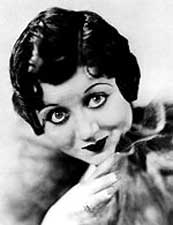 Mae Questel (1908-1998), shown here at the right, provided the voice of Betty Boop exclusively from at least 1932 to 1939. She also sang in the very first Betty cartoon in 1930, but did not voice Betty regularly until 1932.
Mae Questel (1908-1998), shown here at the right, provided the voice of Betty Boop exclusively from at least 1932 to 1939. She also sang in the very first Betty cartoon in 1930, but did not voice Betty regularly until 1932.
She also voiced Olive Oyl, which is obvious only after you know it. She continued to be Olive long after Betty's heyday ended, & extended her voice work to Little Lulu, Little Audrey & Casper the Friendly Ghost.
Her last public outing as the voice of Betty was in old age, as she could still do the Bronxy baby voice in 1988 for Who Framed Roger Rabbit, where Betty is shown in reduced circumstances, working as a cocktail waitress because there's just no work anymore for black & white characters.
Mae had been in vaudeville since she was a teenager, where Max Fleischer first saw her when she was doing a Helen Kane impersonation. Because she was an imitation, Mae never really had a recording career of her own (apart from a novelty hit in which she sounded like a child singing "Good Ship Lollipop" which sold a great many copies). But she could get away with being a cartoon voice because cartoons very commonly caricatured celebrities. Tragically for Helen Kane, the cartoon voice would in short order obliterate the original from public awareness.
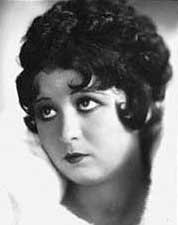 Petite Helen (1903-1966), shown here at the left, at only five feet height was the flapper who invented "boop-oop-a-doop." She had short curly hair, enormous eyes, a round face & ever so slightly chubby figure, making her easily imitated or caricatured. Petite Helen (1903-1966), shown here at the left, at only five feet height was the flapper who invented "boop-oop-a-doop." She had short curly hair, enormous eyes, a round face & ever so slightly chubby figure, making her easily imitated or caricatured.
Her biggest hit was "I Want to be Loved By You," which Betty would one day sing as well. In 1928 she was earning more than $5,500 a week for live performances & was all the rage in New York. But her regional fame could not compete with the nationwide distribution of Betty Boop cartoons in every small-town theater.
The 22 recordings she made from 1928 to 1930 defined flapper music, but after 1930 her career faded in great part because people began to think she was a Betty Boop impersonator.
In 1930 Betty appeared in her first cartoon Dizzy Dishes as a the girlfriend of Bimbo. At that time thecaricature of was Kane rendered as a cute doggy, & for a couple cartoons thereafter Betty had dropping dog-ears, startling to see now since there's no explanation of the ears.
Even after Bimbo became her pet dog instead of her lover dog, a weird sexual tension existed between them, for just as it took a while to realize Betty didn't need the lolling ears, so too it took a while to change the direction of her being half a doggy couple.
By 1932 in films like Mysterious Mose the Betty Boop everyone remembers was in full jazzy sway. It was that year that Helen had had enough, & brought a quarter million dollar suit against Paramount of the Fleischers over the misappropriation of her entire act. It was in the courts for two years & in the end she lost even though it was obvious her entire image as well as her voice was coopted to her career's detriment.
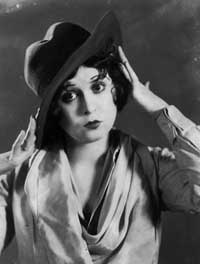 Paramount had trucked out three boop-a-doop girls trying to prove they didn't do what they obviously did, but it was the lucky discovery black singer "Baby Esther" who booped before Helen that convinced Judge McGoldrick that "the flapper sound" was not the creative property of Helen Kane. Paramount had trucked out three boop-a-doop girls trying to prove they didn't do what they obviously did, but it was the lucky discovery black singer "Baby Esther" who booped before Helen that convinced Judge McGoldrick that "the flapper sound" was not the creative property of Helen Kane.
Paramount had signed her to a movie deal in 1929, but sabotaged her by giving her minor roles in films starring B actors, or in Dangerous Nan McGrew (1930) starred her opposite a leading man no one in their right mind would pay a dime to see. Helen as Dangerous Nan is shown in the photo here at the right
The studio could blame her failure as a star on changing tastes when the Depression put the kabosh on Roaring Twenties decadence. But that lie is evidenced by the fact that Betty Boop had her high point of popularity just as Helen's faded. Betty even had a Depression Era radio program, with Mae doing an afternoon & evening show every weekday as Betty.
Mae Questel is perhaps not to be too much blamed for bringing down Helen's career, as Helen set a much-copied style & it's hardly Mae's fault she stumbled onto voice work with the greatest animators of the era. But she's definitely to be faulted for giving false evidence against Helen during the two-year court case, as Mae knew full well who she copied, & lied in service to the hand that fed her.
Cab Calloway did the numbers for Betty's friend Koko the Clown & it's kind of too bad that if Helen was to be usurped by Betty, Helen couldn't do that work herself. But after a $5,500 a week joyride on the live stage, Helen might've been expensive, & you just know Mae didn't get paid much.
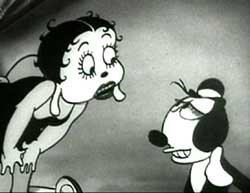 Dizzy Dishes (1930) was Betty Boop's first film, though she was not yet named. The song behind the credits had promised the setting would be a cabaret, though the acts will prove minimal. It begins with a choras of flapper kitties sing "Ha Ta Ta" as we watch waiter Bimbo the Dog take orders in the cafe, then rush in the back & start cooking.
Dizzy Dishes (1930) was Betty Boop's first film, though she was not yet named. The song behind the credits had promised the setting would be a cabaret, though the acts will prove minimal. It begins with a choras of flapper kitties sing "Ha Ta Ta" as we watch waiter Bimbo the Dog take orders in the cafe, then rush in the back & start cooking.
While bringing out one of the orders, he encounters the as-yet unnamed Betty Boop standing on a table singing "Lovin' I have to have lovin'. I have to have boop-poop-a-doop" & so on, entirely in the style of Helen Kane. Opinion varies as to whether Mae Questal voiced the first Betty cartoon, but I think she did; sounds like her; but she wouldn't be doing Betty exclusively until 1932. Just my take on the divided opinion.
She's not as carefully drawn as in later cartoons so a bit freakish in her facial expressions, but still fully formed as Betty despite that she has puppy-ears, all of the cafe's patrons being animals. She's more dog-like here than ever again, but even here it could be missed except for those ears.
Bimbo immediately falls in love. Betty finishes the song & Bimbo sings with a dancing roast duck as his partner. The patron who was supposed to get the duck is so hungry from waiting that he eats the table. At the end Bimbo nonsensically carves a wooden train out of a butcher's block & rides it through the wall, abandoning his cafe.
This was an interesting debut for Betty, who is a minor character. The cartoon is uneven but in the main a lot of fun.
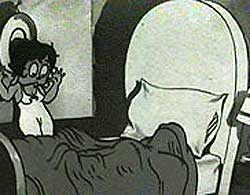 In Betty Boop's second cartoon outing, the tunefully Halloweenesque tale of Mysterious Mose (1930), she wakes up to scary noises in the old dark house. In Betty Boop's second cartoon outing, the tunefully Halloweenesque tale of Mysterious Mose (1930), she wakes up to scary noises in the old dark house.
A couple things to note here is that while Betty is the familiar flapper singer, she still has the long dangling ears because she was created to be Bimbo the Dog's girlfriend. And second, for this very reason, Bimbo has first billing in the opening credits, despite that the script treats Betty as the star.
Betty has a large range of facial expressions in Mysterious Mose & she's sexily animated, despite those odd ears. Dog-Betty was designed by Grim Natwick rather than the Fleischer brothers, & his penchant for the macabre is all over Mysterious Mose as well, in which he refined Betty into the beautiful flapper but so loving the odd he just couldn't let go of her having doggy ears, only later replacing the dog ears with hoop earrings to keep the visual balance.
The title jazz song is a delight & was almost certainly written for the cartoon, for the earliest recordings of the song do not predate the cartoon. Though never exactly a jazz standard it certainly proved itself worthy of a life of its own.
Betty is so scared even her toes are hugging each other for comfort. Oh no! There's a ghost in the bed with her! Betty runs off in her nighty & begins singing, "There's a man of mystery who's roaming through the land. OO-oo-OO-oo-OO."
Mae Questel is frequently credited as the actual singer in this, & it sure sounds like her doing Helen Kane. But if Mae was doing voice work for the Fleischers before 1932, she wouldn't as yet have been the sole Kane impersonator voicing Betty.
Bimbo the dog arrives in the middle of the night as a housebreaker & begins carrying on in various surreal manners, & sings the jaunty tune, "Everybody talks about me everywhere you go. Who I am or what I am nobody seems to know." Betty is by turns attracted to the burglar & afraid of him.
The instrument-playing bugs in the house identify him as Mysterious Mose. In the end, for no reason, Bimbo as Mysterious Mose blows up & his body parts are laying all over the floor. ere the Fleischer brothers stoners or what?
Mysterious Mose is the best early "ears of dog" Betty Boop cartoons though nowhere near the equal of the splendid similarly themed Old Man of the Mountain (1933). Curiously, though Betty's almost fully formed after just two cartoons, in cartoons to follow she will laps into other aspects, not always singing like Helen Kane.
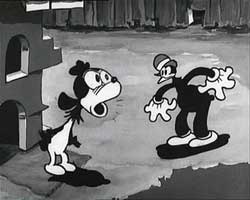 Bimbo had a career before ever there was Betty, & was expected to become the bigger star. Though he'd later take a distant backseat to Betty, in Swing You Sinners! he's definitely the star.
Bimbo had a career before ever there was Betty, & was expected to become the bigger star. Though he'd later take a distant backseat to Betty, in Swing You Sinners! he's definitely the star.
This & Mysterious Mose are the earliest of the Fleischer Brothers' cartoons to fully mix macabre surrealism & ragtime, & both feature Betty & Bimbo together.
Sinners was selected for its quality & historical significance by the ASIFA-Hollywood Film Preservation Program for the full restoration treatment.
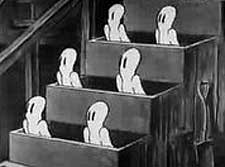 The scariest bits sneak up on the viewer, for at the start he is trying to catch a chicken but has bitten off more than he can chew since the chicken gets the upper hand. A bulldog police officer pursues Bimbo as a chicken thief. The scariest bits sneak up on the viewer, for at the start he is trying to catch a chicken but has bitten off more than he can chew since the chicken gets the upper hand. A bulldog police officer pursues Bimbo as a chicken thief.
Avoiding the cop, he takes refuge in a graveyard & is haunted by tombstones & ghosts & sentient gravestones & even a clod of grave soil that comes alive as well as a creepy tree, all singing to him threateningly, "You'll never rob again."
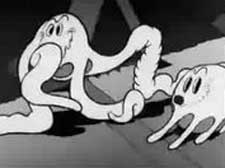 One tombstone says "For Rent" on it, prepared for Bimbo. Our doggy hero escapes the graveyard & takes refuge in a barn. One tombstone says "For Rent" on it, prepared for Bimbo. Our doggy hero escapes the graveyard & takes refuge in a barn.
The shadows & a pile of hay spring to life to singing punningly "Swing You Sinners," a call & reply number with Bimbo denying that he's still the sinner he used to be, & numerous ghosts as choras & musicians after him.
The hot jazz novelty song was not "Swing" but "Sing You Sinners" written by W. F. Harling & S. Caslow. A lot of other cool music enriches Bimbo's adventure, instrumentations of Rube Bloom's "Song of the Bayou" W .H. Myddleton & E. B. Marks' "Down South" & Maurice Barons' "March of the Spooks," besides a bit of an old Negro spiritual, "Thing I Used to To."
Escaping from the barn, the barn itself raises itself on legs & chases Bimbo down the road, together with all sorts of demonic creatures stretching off to the horizon.
This is a totally wild & wonderful little film with some incredible bits, like the scat-singing frog. It reminds us how it could be that Bimbo would have top billing for a little while even after not-yet-named Betty came into the cast.
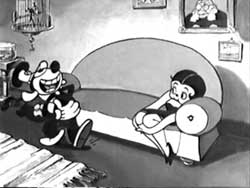 Opening with a square-sailed ship of sailors singing "A Sailor's Life," the ship itself singing bass, pealed potatoes in the choras, Barnacle Bill (1930) soon finds the ship anchored in port. The fat aggressive captain insists nobody leaves the ship, but Bill wants his shore leave in order to visit his girlfriend Nancy Lee, played by Betty Boop. Opening with a square-sailed ship of sailors singing "A Sailor's Life," the ship itself singing bass, pealed potatoes in the choras, Barnacle Bill (1930) soon finds the ship anchored in port. The fat aggressive captain insists nobody leaves the ship, but Bill wants his shore leave in order to visit his girlfriend Nancy Lee, played by Betty Boop.
Though this cartoon predates Mae Questrel doing Betty's voice, she sounds pretty similar singing "Who's that Knocking at My Door?" It's her boyfriend Barnacle Bill (Bimbo). Nancy & Bill sing a charming if not particularly jazzy duet, with additional lyrics throughout the cartoon. Nancy Lee has long doggy ears still, as she a flapper girl-dog appropriate for Bimbo to date or flirt with.
Bill & Nancy's songs are not the sort of jazz Betty performed in her best films. As Nancy she's rather freakish in the marionette way she moves her legs & when she screws up her face she's horridly ugly. Had there been a "progression" of a primitive Betty to the Betty we are happiest to know & love, Barnacle Bill would have had to have pre-dated the sexier Mysterious Mose, but it's not the case.
Nancy flirts outrageously, her short skirt hiking up her skirt dangerously far as she seduces an excessively antic Bill. Eventually the shades go dow are apparently "doing it." The neighborhood cats gossip about it over the fence, but when the shades accidentally flip up, Bill & Nancy are just playing checkers.
Nancy/Betty makes more appalling faces showing sadness when it's time for Bill/Bimbo to return to sea, promising never to return. There follows an unrelated sequence of the angry Captain catching up to Bill & chasing him through stormy streets until Bill falls in the sea & joins a choras-line of fat mermaids.
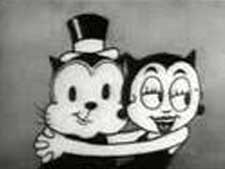 Taking another giant step backward from Mysterious Mose, which came so close to Betty's classic design, familiar voice, & sexuality, this time out, in Any Little Girl that's a Nice Little Girl (1931), she's completely revamped to be a kitty. Her cat ears look a bit like horns.
Taking another giant step backward from Mysterious Mose, which came so close to Betty's classic design, familiar voice, & sexuality, this time out, in Any Little Girl that's a Nice Little Girl (1931), she's completely revamped to be a kitty. Her cat ears look a bit like horns.
Instead of lovely gams she has rubbery-legs like the majority of cartoon characters from the 1920s. Physically this is one of the least sexy Betties.
The title theme song, sung about her, asserts that a girl doesn't have to be good looking if she can cook. Betty sings a fragment of "What Wouldn't I Do For That Man" a hit song from two years before, but it's not in the Helen Kane style, & the singer is unknown.
Really this barely registers as a Betty cartoon as it soon turns into a "follow the bouncing ball" singalong for the theater goers. An unknown tenor sings "Any little girl who'se a nice little girl is the right little girl for me." We watch cat-betty dance with her casanova boyfriend (a cat in a tophat) over some of the lyrics. The novelty of Betty being a cat makes it worth a gander for curiosity's sake only.
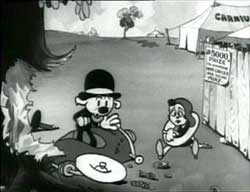 The Robot (1932) is a strange cartoon to be placed placed in the Betty Boop canon though not really featuring Betty.
The Robot (1932) is a strange cartoon to be placed placed in the Betty Boop canon though not really featuring Betty.
By the time The Robot was made, Betty in other cartoons had taken on her well-known personality & was no longer a dog-girl. The flapper in The Robot has the same doggy ears that Betty had in 1930 & 1931.
It would almost seem this was really an earlier cartoon not released right away, made when Betty was not yet named & was still in transition as different hired animators attempted different takes while her slowly developing character & appearance.
If so, it would be one of the earliest Betties & would have had to have been bouncing around Fleischer studios since 1929, conceivably predating even the "officially first" Betty film Dizzy Dishes, as The Robot is overall too primitive for Fleischer's 1932 product.
Bimbo wants to marry the flapper. To get some prize money he decides to attempt to go one round with a professional boxer. He doesn't have a chance, so with the flapper's help Bimbo transforms his automobile into something of a robot suit, & pits the car-robot against the boxer.
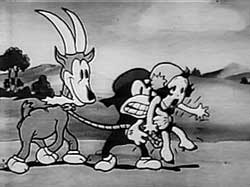 After winning, the "robot" turns back into a car & Bimbo & the flapper drive round & round the boxing ring. It's not a good cartoon, but just wacky enough to entertain even so. After winning, the "robot" turns back into a car & Bimbo & the flapper drive round & round the boxing ring. It's not a good cartoon, but just wacky enough to entertain even so.
In Hide & Seek (1932) is often listed as a Betty Boop cartoon. It's not really about dark-haried Betty, but stars a very blonde flapper instread.
A kidnapper named I. Grabber is a rat-character. He's after the pretty flapper girl.
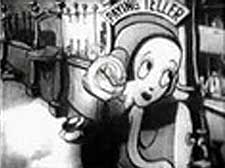 A dog cop (who may well be Bimbo, whose design had not fully settled into the figure who'd soon become familialr). A dog cop (who may well be Bimbo, whose design had not fully settled into the figure who'd soon become familialr).
The cop goes to rescue the flapper, the chase taking them out of town & into the crater of a volcanic mountain.
Deep into the volcano the cop pursues the rat & almost saves the flapper, but that a demon of hell gets them & locks them in a box. It's up to the cop's sentient motorcycle to save the day, escaping from Hell through the hole to China, where the cop & the flapper get married.
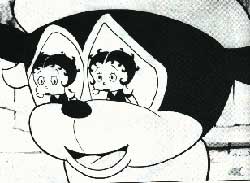 Betty was not really so-named from 1930 to early 1932, & the title cards that name her were added for re-releases. She did not yet have a name in the first of her films of 1932, Any Rags, though her look & in general her character was now set. She'd truly & officially be called Betty Boop soon in that same year in Boop-oop-a-doop (1932). Betty was not really so-named from 1930 to early 1932, & the title cards that name her were added for re-releases. She did not yet have a name in the first of her films of 1932, Any Rags, though her look & in general her character was now set. She'd truly & officially be called Betty Boop soon in that same year in Boop-oop-a-doop (1932).
If she seems only to be only a support player Any Rags, it's because Bimbo was not yet reduced to a secondary cast member. Betty before so named was Bimbo's girlfriend with the expectation that Bimbo would be the bigger star, & in Any Rags she is still pretty much following this pattern, despite that she no longer has the dog ears & it might not be as appropriate for her to have a cross-species relationship.
Apartment dwellers are tired of hearing Bimbo the rag man shouting for rags or trash as he passes in the street below their windows. So they begin chucking junk at him. Bonked on the head, Bimbo staggers around envisioning a horn-blowin' ragtime angel singing over his head.
Betty pokes her head out a window & sings the line, "Take out the rags, here comes the garbage man!" She tosses Bimbo her garbage in a bag, then Bimbo continues on his way.
Bimbo gathers a crowd & begins auctioning off the junk he gathered, including to Koko the Clown who makes a token purchase & takes his cameo bow.
But when he opens Betty's sack of junk, it includes Betty herself, who leaps up & hugs Bimbo. For climax they role down the hill in the cart, & it flips over turning into a home for the two of them.
copyright © by Paghat the Ratgirl
|
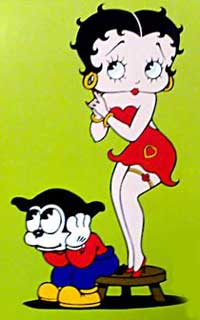

 Petite Helen (1903-1966), shown here at the left, at only five feet height was the flapper who invented "boop-oop-a-doop." She had short curly hair, enormous eyes, a round face & ever so slightly chubby figure, making her easily imitated or caricatured.
Petite Helen (1903-1966), shown here at the left, at only five feet height was the flapper who invented "boop-oop-a-doop." She had short curly hair, enormous eyes, a round face & ever so slightly chubby figure, making her easily imitated or caricatured. Paramount had trucked out three boop-a-doop girls trying to prove they didn't do what they obviously did, but it was the lucky discovery black singer "Baby Esther" who booped before Helen that convinced Judge McGoldrick that "the flapper sound" was not the creative property of Helen Kane.
Paramount had trucked out three boop-a-doop girls trying to prove they didn't do what they obviously did, but it was the lucky discovery black singer "Baby Esther" who booped before Helen that convinced Judge McGoldrick that "the flapper sound" was not the creative property of Helen Kane.


 The scariest bits sneak up on the viewer, for at the start he is trying to catch a chicken but has bitten off more than he can chew since the chicken gets the upper hand. A bulldog police officer pursues Bimbo as a chicken thief.
The scariest bits sneak up on the viewer, for at the start he is trying to catch a chicken but has bitten off more than he can chew since the chicken gets the upper hand. A bulldog police officer pursues Bimbo as a chicken thief. One tombstone says "For Rent" on it, prepared for Bimbo. Our doggy hero escapes the graveyard & takes refuge in a barn.
One tombstone says "For Rent" on it, prepared for Bimbo. Our doggy hero escapes the graveyard & takes refuge in a barn.


 After winning, the "robot" turns back into a car & Bimbo & the flapper drive round & round the boxing ring. It's not a good cartoon, but just wacky enough to entertain even so.
After winning, the "robot" turns back into a car & Bimbo & the flapper drive round & round the boxing ring. It's not a good cartoon, but just wacky enough to entertain even so. A dog cop (who may well be Bimbo, whose design had not fully settled into the figure who'd soon become familialr).
A dog cop (who may well be Bimbo, whose design had not fully settled into the figure who'd soon become familialr).